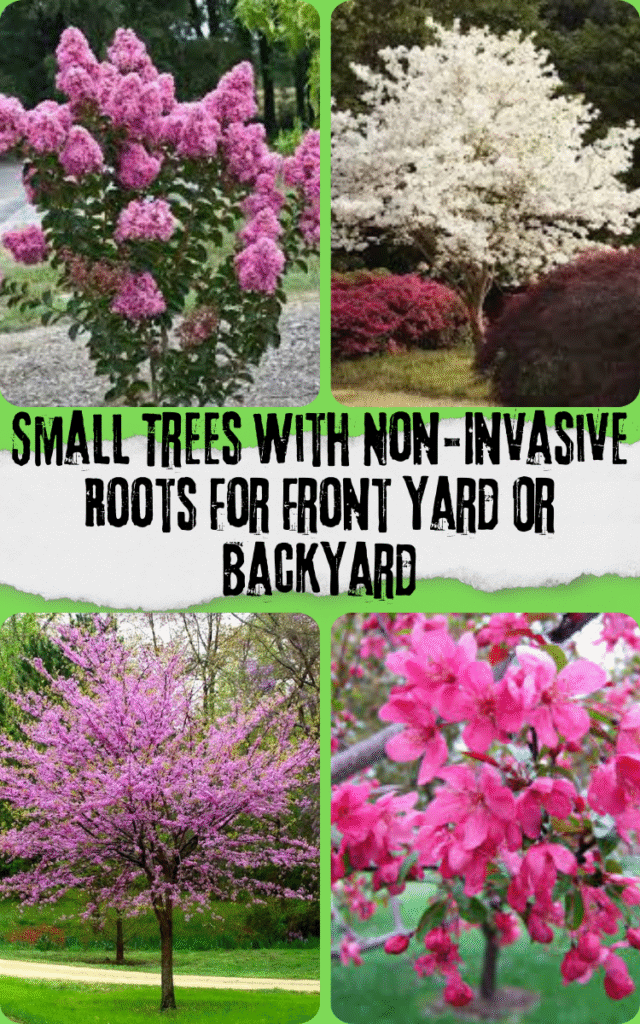
I’ve always believed that planting a tree is one of the most rewarding things you can do for your yard. Trees bring shade, beauty, and life to a space in a way that shrubs or flowers just can’t match. The trouble is, many people plant a tree without realizing how destructive the wrong root system can be. I’ve seen sidewalks lifted, pipes clogged, and driveways cracked—all because of invasive roots.
The good news is that not all trees cause this kind of chaos. Some species are naturally shallow-rooted and well-behaved, making them perfect choices for smaller yards and landscaped spaces. They’ll give you the greenery and seasonal interest you’re after without the worry of expensive repairs later.
If you’re planning to add a tree to your front or backyard, I’ve rounded up thirteen of the best small trees with non-invasive roots. Each one has its own personality—some are showy, some are subtle, and all of them are safe for tight spaces.
1. Japanese Maple (Acer palmatum)

Japanese Maples are one of those trees that stop you in your tracks. Their delicate leaves shift colors throughout the seasons, from soft spring greens to fiery autumn reds. They don’t grow tall—most stay under 20 feet—which makes them perfect for a modest yard.
One of the biggest perks is their root system. Japanese Maples have shallow, fine roots that spread gently without causing damage to nearby structures. I’ve seen them planted just a few feet from patios and walkways, and they settle in nicely without lifting the ground around them.
These trees shine as focal points. Place one near your front entry or in a backyard corner where you want a touch of elegance. With a little pruning to shape their canopy, they’ll look like living works of art.
2. Dogwood (Cornus florida)

Dogwoods have a quiet charm that sneaks up on you. In spring, they burst into pink or white blossoms, and by fall, they surprise you again with bright red berries and colorful foliage. Their size makes them friendly to smaller spaces, rarely exceeding 25 feet.
Their roots are shallow and non-aggressive, which means they won’t compete with nearby foundations or pipes. They do best in rich, slightly acidic soil, and while they appreciate some shade, they can handle filtered sunlight too.
I like to think of dogwoods as “conversation trees.” Plant one near a seating area or patio, and it’ll become a seasonal highlight that draws attention without overwhelming the space.
3. Eastern Redbud (Cercis canadensis)
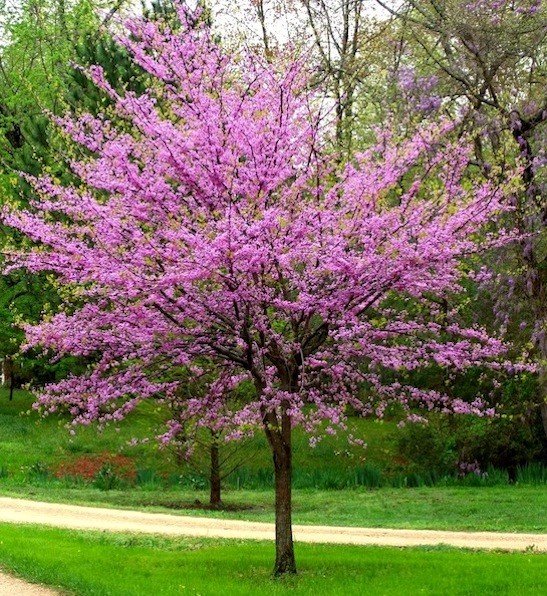
If you want a tree that announces spring in the boldest way possible, the Eastern Redbud is it. Its branches explode with pink-purple blossoms before the leaves even appear, and the heart-shaped foliage that follows is just as lovely.
Despite the dramatic flowers, the tree itself is modest in size—usually topping out around 20–30 feet. Its roots are not known to spread aggressively, making it safe for planting close to walkways or even near your house.
I once planted a Redbud outside a kitchen window, and every spring it turned that view into a postcard. If you’re looking for a small statement tree, this one delivers without causing a single worry underground.
4. Serviceberry (Amelanchier spp.)
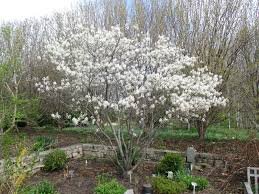
Serviceberries are like the Swiss army knife of small trees: they bloom in spring, bear edible berries in summer, and put on a fiery color show in the fall. Birds love them too, so you’ll notice more wildlife around once one is planted.
The roots are shallow and rarely invasive, making them safe near utility lines or sidewalks. They don’t need much fussing over once established, though they’ll reward you with better growth if you plant them in slightly moist soil.
These trees look stunning in a backyard garden or as part of a mixed border. I enjoy them most when planted where I can easily reach the berries—they’re sweet and perfect for snacking right off the branch.
5. Crape Myrtle (Lagerstroemia indica)
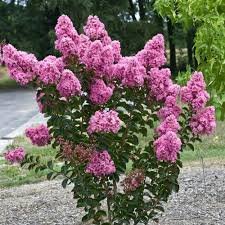
Few trees can match the long bloom time of a Crape Myrtle. Their clusters of flowers last through summer, and the peeling bark adds interest even in winter. Depending on the variety, you can find compact versions that stay around 10–15 feet tall.
The roots of Crape Myrtles are non-aggressive, spreading close to the surface without breaking through concrete or pipes. They’re tough, too, handling heat and less-than-ideal soils without much complaint.
They work beautifully along driveways or as a row of small ornamental trees in the front yard. The flowers come in shades of pink, white, purple, and red, so you can pick the one that best matches your outdoor color scheme.
6. Magnolia ‘Little Gem’
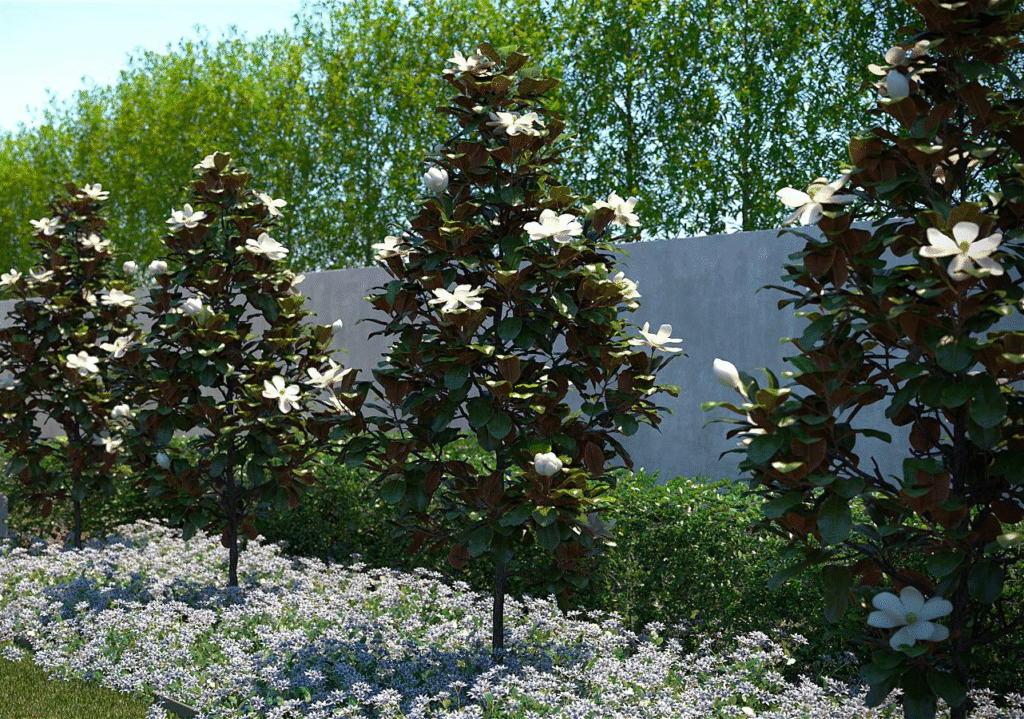
Magnolias are often thought of as massive, sprawling trees, but the ‘Little Gem’ variety stays compact, usually under 20 feet. It still delivers those classic large white flowers and glossy green leaves but in a much smaller package.
The roots of ‘Little Gem’ are slower to spread and far less aggressive than those of its larger relatives. That makes it possible to enjoy the elegance of a magnolia without worrying about damage to your yard.
I’ve seen them used as entryway trees, flanking a front porch for a stately but manageable look. Their year-round evergreen foliage ensures your yard never feels bare.
7. Olive Tree (Olea europaea ‘Little Ollie’ or dwarf varieties)
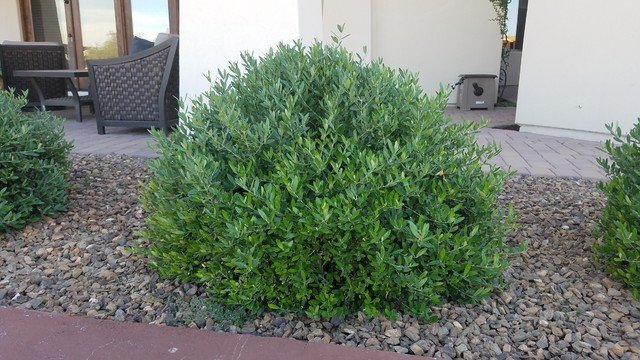
There’s something timeless about olive trees, and dwarf varieties make them suitable even for modest backyards. Their silvery-green leaves bring a Mediterranean feel, and some varieties will even bear small fruits.
When you stick with dwarf cultivars, the root systems remain small and non-invasive. They’re also surprisingly tolerant of dry conditions, which makes them low-maintenance once they’re established.
For smaller spaces, olive trees look fantastic in large containers on patios or courtyards. They provide structure and style without the hassle of invasive roots.
8. Japanese Tree Lilac (Syringa reticulata)
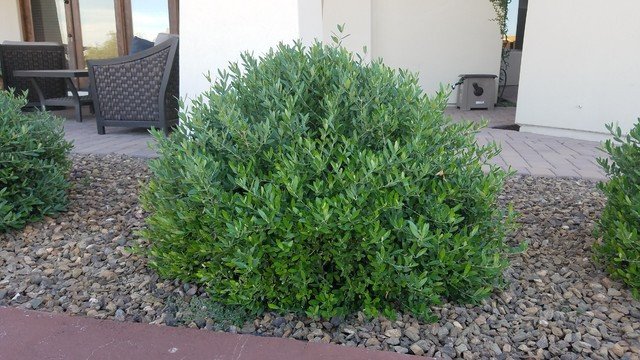
Japanese Tree Lilacs are not only beautiful but also fragrant. In early summer, they bloom with clusters of creamy white flowers that smell delightful and attract pollinators.
Their roots are considered well-behaved, spreading slowly and staying close to the surface. That makes them safe for planting near driveways, fences, or even in narrow side yards.
Because of their upright form, they fit nicely where space is limited. Plant one along the edge of a yard, and you’ll have shade, flowers, and fragrance all in a compact package.
9. Hawthorn (Crataegus spp.)
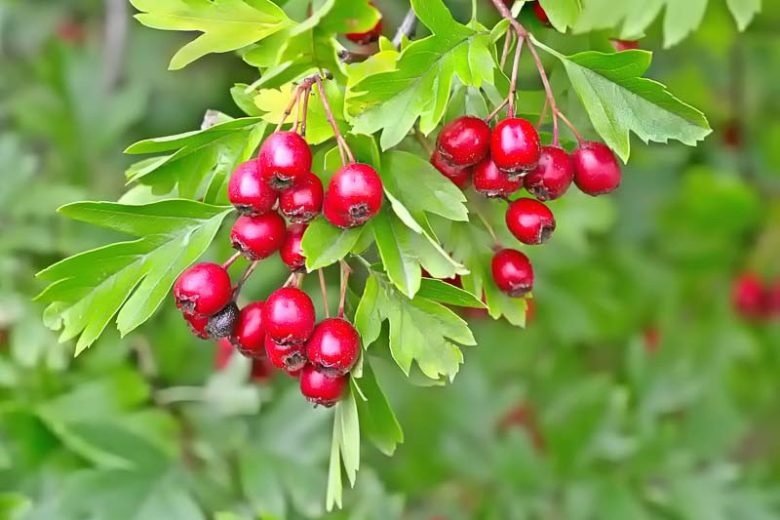
Hawthorns are small, tough trees that carry an old-world charm. Their spring flowers are cheerful, and their fall berries feed birds through the colder months. Some varieties even have attractive thorny branches that act as a natural deterrent for intruders.
Despite their resilience, Hawthorns don’t have aggressive root systems. They’re shallow-rooted and won’t interfere with foundations or underground pipes.
They’re great for creating a wildlife-friendly yard. I’ve seen them planted in hedgerows or as standalone accent trees, and in either case, they draw in birds and pollinators.
10. Cherry Blossom (Prunus serrulata or dwarf cultivars)
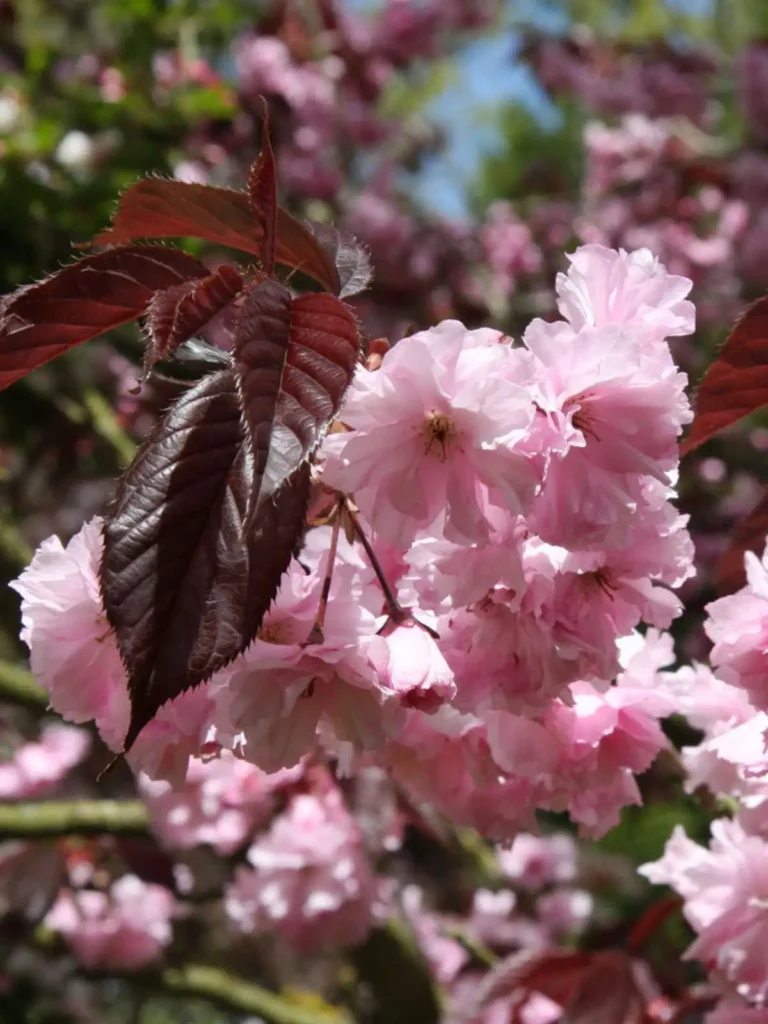
Cherry Blossom trees are famous worldwide for their springtime display of delicate pink and white blooms. Even smaller dwarf cultivars can pack an incredible visual punch without overwhelming your yard.
Their root systems are generally non-invasive when you choose ornamental or dwarf varieties. Unlike larger cherry species grown for fruit, these stay manageable both above and below ground.
They’re perfect for planting in the front yard as a seasonal highlight. A single cherry blossom tree can transform your space into something magical every spring.
11. Witch Hazel (Hamamelis spp.)

Witch Hazel is one of the few trees that bloom in the heart of winter. Its spidery yellow or orange flowers are fragrant and bring life to an otherwise dormant season.
The roots are non-aggressive, spreading modestly and staying close to the tree itself. Witch Hazel is also compact, rarely exceeding 15–20 feet, which makes it easy to fit into tight spaces.
I think of Witch Hazel as a tree for gardeners who want something special. Plant it near a window or pathway where you’ll notice its winter blooms, and it’ll brighten your coldest days.
12. Crabapple (Malus spp. dwarf varieties)

Crabapples are among the most ornamental small trees. In spring, they burst into pink or white blossoms, and by fall, their small fruits add color and attract birds.
Dwarf crabapple varieties are especially yard-friendly, with root systems that don’t spread aggressively. They’re also resistant to many common tree problems, making them relatively low-maintenance.
In a front lawn, a dwarf crabapple makes a wonderful centerpiece. You’ll enjoy flowers, fruit, and fall color in a tree that stays compact and manageable.
13. Smoke Tree (Cotinus coggygria)
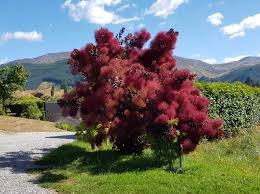
Smoke Trees earn their name from the hazy, cloud-like plumes they produce in summer. Add in their dramatic fall foliage, and they easily become a standout in any yard.
Their root systems are shallow and non-invasive, so they won’t cause issues with sidewalks or pipes. They’re also drought-tolerant once established, making them a good option for lower-maintenance landscapes.
I love Smoke Trees as accent pieces. They bring an almost whimsical look to a garden and provide color and interest for much of the year.
Tips for Planting Small Trees with Non-Invasive Roots
Even though these trees are safe choices, it’s always smart to plant with care. Give each tree enough distance from your home or driveway—at least 5–10 feet is a good rule of thumb for smaller species.
Soil preparation also makes a difference. Adding compost and mulch helps the roots settle and reduces the need for aggressive spreading. Regular watering during the first couple of years ensures they establish properly without stress.
By planting thoughtfully, you’ll help the tree thrive while keeping your landscape safe and low-maintenance.
Wrapping Up
Small trees with non-invasive roots are proof that you don’t have to sacrifice beauty for practicality. They bring seasonal color, shade, and personality to your yard while keeping sidewalks, pipes, and foundations safe.
The real joy comes from watching them grow over the years, becoming a familiar part of your home’s story. A well-chosen tree is more than just landscaping—it’s a companion that transforms your outdoor space into something memorable.
Whether it’s a Japanese Maple by the front door, a Crape Myrtle lining the drive, or a Serviceberry feeding the birds, the right tree has a way of making your yard feel complete.

